There was no immediate alarm, no shrill warning whistle to pierce the silence of a sleeping prison on the early morning of Monday, April 14, 1941. . . .
_
 |
| Ralph Blumenthal, longtime New York Times. investigative reporter now heads its Houston bureau. Click image for more about him.
|
|
On the third floor of the hospital building on the bluff overlooking the
river, Joseph “Whitey” Riordan, a bulky, towheaded stevedore and ex-stickup
man of the "Paper Bag Bandits," a gang notorious for carrying away its loot in
bags, was in the infirmary complaining of an appendicitis-like pain in his
stomach.
That put him near one of his former Paper Bag cronies, John “Patches” Waters, a slight and balding thirty-year-old orderly working in the infirmary.
Also present on sick call, complaining of a sprained back, was Charles McGale, a dark and wiry mechanic, master lock-picker, and prison trusty, at forty-five the old man of the three.
The night before, Waters had met Riordan and McGale in the bathroom and slipped them each a bundle in a towel.
Their rendezvous in the infirmary had been a year in the plotting. Waters had spotted a milk truck from Newburgh that made daily deliveries into the prison. He contacted a pal on the outside, Edward Kiernan, who started visiting Sing Sing pretending to be Waters’s brother Thomas.
In the visiting
room, they laid their plans. Kiernan began tailing the milk truck, noting its
route to Sing Sing.
By March they were ready to act. Kiernan and a partner, William Wade, went to Newburgh with three guns and three sets of handcuffs tied up in a rag.
_
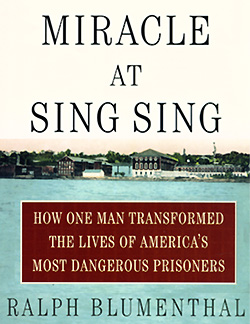 |
Cover of Ralph Blumenthal's
Warden Lewis E. Lawes bio
Miracle at Sing Sing.
Click image for more about it.
|
|
When the truck backed up to a loading platform in Newburgh, Kiernan wriggled beneath the undercarriage and strapped the contraband to the crankshaft.
When the truck reached Sing Sing, McGale, a trusty with privileges, was waiting to relieve it of its illicit cargo.
Meanwhile, he had made a set of keys that unlocked a series of doors from the cellar of the hospital to a utility tunnel of steam pipes, which in turn led to the
New York Central Railroad tracks that bisected the prison between the hospital and the river.
He crawled through the tunnel to . . . where an iron plate closed it off. He sawed the plate in half and carefully replaced it so it would not be noticed. . . he hid [rope] under a steam pipe, and . . . crawled hack to the hospital.
Promptly at 2 AM. that Monday, guard John Hartye, a fifty-five-year-old
bachelor from the Bronx who had been at Sing Sing for more than eight
years, began his patrol of the infirmary, unarmed, as was the practice for all
but the guards on the wall, and telephoned his all-clear to the switchboard.
Suddenly, McGale, Waters, and Riordan leaped from their beds, snatched
guns from the end tables, and fell upon Hartye. He struggled and went down
with two bullets in his body. A prisoner in the infirmary with a heart condition saw the shooting and collapsed with a fatal heart attack . . . .
The three prisoners, in gray trousers and white shirts, bolted into the corridor and encountered a trusty, awakened by the shots. Waters held a gun on
him and marched him down to the basement. Upstairs, Riordan had surprised another guard and taken him hostage at gunpoint . . .
The guard too was herded to the basement, where he and the trusty
were shackled . . .
_
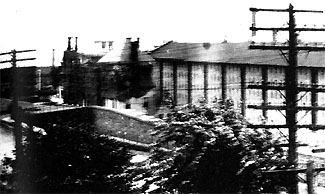 |
| The above image of the railroad tunnel stop used at Sing Sing until the 1970s is from a photo in Guy Cheli's Images of America: Sing Sing Prison as is the top-of-the-page aerial photo used as the title image for this NYCHS presentation on the 1941 escape. Click the freight tracks image to access NYCHS' presentation of text and image excerpts from Cheli's book.
|
|
[The three inmates] made their way to the tunnel, crawled
through, and punched . . . through the presliced plate. With the rope . . . they lowered themselves thirty feet down to the railroad
tracks. Then they ran a few hundred yards north along the tracks to the station plaza to meet Kiernan and Wade in their stolen getaway car.
Everything had gone smoothly -- too smoothly. The three escapees were
half an hour early. Kiernan and Wade, thinking they had time to kill until
their cronies arrived, were still in a nearby bar, leaving behind two other accomplices who were to spirit Kiernan and Wade away in a separate car. . . .
Just then Ossining patrolman James W. Fagan and his partner, William
Nelson, drove through the depot plaza on routine patrol. Fagan, thirty-five,
with seven years on the police force and a wife and nineteen-month-old son
at home, . . . noticed Riordan, Waters, and McGale, who
were wandering around in search of . . . Kiernan and Wade.
He called them [Riordan, Waters, and McGale] over. The answer was a shot through the windshield that
pierced a button on his uniform and lodged in his heart. He staggered out of
the car and emptied his weapon at the fugitives, missing wildly, before collapsing dead.
Nelson . . . ran back toward the car, firing from two hundred feet away and managing to drill Waters through the forehead, killing him instantly. He radioed frantically for aid while Riordan and McGale fled.
_
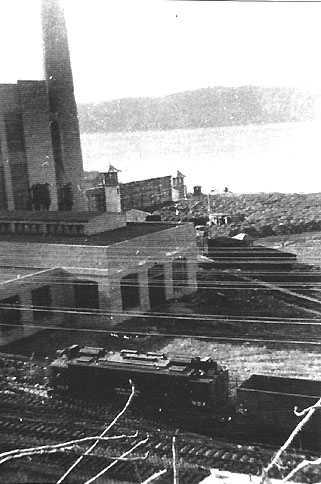 |
| The above image of the railroad freight delivery tracks used at Sing Sing until the 1960s is from a photo in Guy Cheli's Images of America: Sing Sing Prison as is the top-of-the-page aerial photo used as the title image for this NYCHS presentation on the 1941 escape. Click the freight tracks image to access NYCHS' presentation of text and image excerpts from Cheli's book.
|
|
The two accomplices also fled, stranding Kiernan and Wade, who had
heard the gunfire from the bar. They waited until it seemed quiet and then
ventured out to a taxi office, where they jumped into a waiting cab and told
the driver to take them to White Plains.
The cabbie had heard something
about a policeman being shot and was suspicious. He delayed . . . until another police
car appeared in the plaza. The taxi driver beckoned it over and the two men
were ordered out at gunpoint.
They insisted they had come to Ossining with a couple of pickups,
“Betty” and “Peggy,” who had rebuffed a pass and marooned them there.
They were taken in for questioning. The stolen getaway car, a 1939 two-
door Plymouth sedan with a submachine gun on the backseat, was soon
found nearby. . . .
By dawn more than a thousand lawmen -- state troopers with bloodhounds, local officers, and Coast Guardsmen in a seaplane, two launches, and two cutters -- had joined the manhunt . . . .
The searchers were tracking the fugitives up the wooded slopes of
Hook Mountain in Palisades Interstate Park when they spotted the pair,
poorly disguised in suede jackets they had found somewhere. A trooper
called, “Come out or we'll let you have it!” Riordan and McGale meekly surrendered, handing over their loaded . 38-caliber pistols.
. . . With two law officers dead, the fury of the police was unleashed on the
shackled prisoners, who were beaten so brazenly that news photographers
were able to show them being punched, knocked down, and yanked around
by the hair.
One photo showed a jackbooted officer astride the two men on
the floor of the station house, a frightened-looking Riordan trying to shield
his body, and a battered-looking McGale clutching his crotch. Out of sight
of the photographers it was worse. Between interrogations by the prosecutor,
Riordan and McGale, cuffed together, were brutalized by troopers and detectives for hours at a time.
The assaults stopped briefly when someone called
out that the prosecutor was coming, and resumed after he left. Riordan's
bridgework was knocked loose, and he nearly choked to death on his false
teeth. His pleas for water were ignored while in front of his eyes an open
faucet gushed tantalizingly . . . .
_
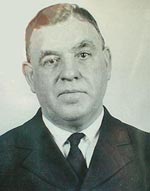 |
| The above image of guard John Hartye, killed in the 1941 escape, appears -- courtesy of Ossining Historical Society -- in Mark Gado's Stone Upon Stone: Sing Sing Prison on Court TV's Crime Library web site. Click image to access NYCHS excerpts from it.
|
|
In Ossining, Patrolman Fagan was memorialized in St. Augustine’s Roman Catholic
Church before the biggest crowd ever to honor a police officer in Westchester.Nine hundred mourners, including Elise [Lawes, wife of Warden Lewis E. Lawes], filled the pews while a
larger number waited outside.
Afterward, the Post Road was closed as five
hundred police officers escorted their comrade to his final rest.
Lawes was in the Bronx, attending the funeral of guard John Hartye.
The ghastly trial of Riordan and McGale and their accused accomplices Kiernan and Wade followed, forcing Lawes to relive the murderous escape,
along with a grotesque new element . . . defendants charged that they
had been savagely beaten to coerce their admissions, although they insisted
that the dead Waters had masterminded the scheme.
The prosecutor, in his opening to the jury, conceded that Riordan had
been “knocked down” by an Ossining police officer, and that a Sing Sing
guard “took a swing” at McGale, but he insisted it was no third degree.
The
defense cited medical evidence of beatings: one month after his arrest, Wade
still bore bruises.
When the defendants took the stand to challenge their confessions, a
gruesome picture emerged. State troopers had mauled McGale, joking that
by the time they were done, he “would admit he killed Lincoln.”
_
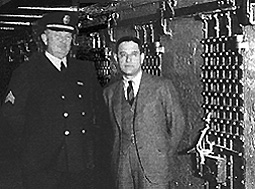 |
| Above: Principal Keeper James Connaughton, in uniform, with Lewis E. Lawes when the latter became warden in 1920. Connaughton served as acting warden briefly in 1913. Below: Lawes with Principal Keeper John J, Sheehy who retired in 1941, the same year as did Lawes.
| _
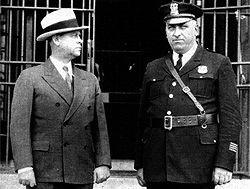
Both above images of Lawes are from NYCHS' presentation of excerpts from Guy Cheli's Images of America: Sing Sing Prison. Click either Lawes image to access it.
|
|
Wade estimated he had been struck a total of fourteen hundred times and strung up by
his wrists 15 times.
He testified that a state police inspector had cautioned his men not to disfigure the prisoner's face.
Yet, he said, they battered him all over and when he started to scream the inspector had given an order: “Gag that bum -- he's disturbing the DA.”
The jury initially deadlocked, soon reached a predictable verdict. Guilty.
Riordan and McGale were to die in the chair. Accomplices Kiernan and
Wade got life. . . .
With the trial over, Lawes knew what he wanted to do.
No one had
thought he would last twenty-one months at Sing Sing, much less twenty-
one years. But now the time was at hand.
He was fifty-seven years old. He
had spent more than thirty-six of his years in service to the state, behind
prison walls. Now he and Elise had bought a small farm in Garrison, a
pretty riverside bluff a few miles up the Hudson across from West Point.
In
July 1941 he resigned, quietly putting in his papers. . . .

